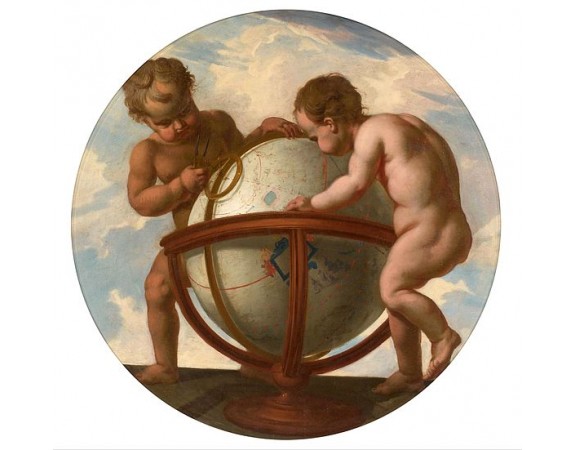Joseph van den KERKHOVE. - "Allégorie de la Géographie".
 cliquez sur l'image pour l'agrandir
cliquez sur l'image pour l'agrandir

Joseph van den KERKHOVE. - "Allégorie de la Géographie".
Date: Bruges, 1669 - 1724
Format: 880 x 880mm.
Color: Beau col. d'époque.
Condition: Huile sur toile. Diamètre : 88 cm.- Oil on canvas round. Diameter : 88 cm (34,60 in.).
Description
Huile sur toile par JOSEPH VAN DEN KERKHOVE. Elève d'Erasme Quillyn le père, le peintre flamand Joseph van den Kerkhove choisit de partir voyager à l'étranger pour compléter sa formation et développer ses talents artistiques.
Il se rend à Paris mais ce séjour ne lui fera pas oublier la manière de son maître. Il se plait à peindre des compositions nobles et grandioses avec des couleurs chaudes. Ses tableaux présentent d'une part des sujets mythologiques et de l'autre des sujets bibliques, ces deux thèmes se retrouvent dans les grandes compositions qu'il a réalisées à Bruges.
Il a peint quinze tableaux sur la vie du Christ pour l'église des Jacobins, quatre autres sur les Œuvres de la miséricorde pour l'église collégiale de Saint-Sauveur, et une composition représentant le Conseil des Dieux sur le plafond de l'hôtel de ville d'Ostende. Passionné par son art, Joseph van den Kerkhove a crée une Académie de peinture à Bruges et en fut le premier directeur.
Provenance : Collection particulière, Belgique.
Oil on canvas, by JOSEPH VAN DEN KERKHOVE.
Deux Putti étudient un globe terestre, l'un d'eux tient un compas. Les informations portées sur le globe sont imaginaires mais les deux cartouches et les bateaux sont typiques du 16e siècle. Van den Kerkhove s'est sans doute inspiré de ses concitoyens Gerard Mercator, Hondius et Blaeu.
Two putty studying a terrestrial globe, one of them holding a pair of dividers. The information on the globe is clearly imaginary but the two cartouches and ships are typically 16th century in appearance. Was van den Kerkhove perhaps inspired by his countrymen Gerard Mercator, Hondius and Blaeu.
Joseph Vanden Kerkhove was a Flemish historical painter who was born Bruges in 1669 and died in 1724 aged 55. He was a disciple of Erasmus Quellinus the elder in whose school he showed himself studious and diligent and his proficiency was proportionable to his work.
When he began to practice his profession he went early to France where he found encouragement and in a few years returned to his own country with a good reception and always painting in the style of his master.
His colours are warm and his design correct, his composition is generally in the "grand taste" and he rarely introduced anything but what seemed necessary to embellish his subject.
He had thoroughly studied the principles of perspective and he was an expert in that branch of his art. The backgrounds of his pictures are usually enriched with classical architecture.
On the ceiling of the town hall at Ostend he painted a very fine design representing "the Council of the Gods" in which there is an ingenious and learned disposition of the figures and it is altogether a masterly execution.
Il se rend à Paris mais ce séjour ne lui fera pas oublier la manière de son maître. Il se plait à peindre des compositions nobles et grandioses avec des couleurs chaudes. Ses tableaux présentent d'une part des sujets mythologiques et de l'autre des sujets bibliques, ces deux thèmes se retrouvent dans les grandes compositions qu'il a réalisées à Bruges.
Il a peint quinze tableaux sur la vie du Christ pour l'église des Jacobins, quatre autres sur les Œuvres de la miséricorde pour l'église collégiale de Saint-Sauveur, et une composition représentant le Conseil des Dieux sur le plafond de l'hôtel de ville d'Ostende. Passionné par son art, Joseph van den Kerkhove a crée une Académie de peinture à Bruges et en fut le premier directeur.
Provenance : Collection particulière, Belgique.
Oil on canvas, by JOSEPH VAN DEN KERKHOVE.
Deux Putti étudient un globe terestre, l'un d'eux tient un compas. Les informations portées sur le globe sont imaginaires mais les deux cartouches et les bateaux sont typiques du 16e siècle. Van den Kerkhove s'est sans doute inspiré de ses concitoyens Gerard Mercator, Hondius et Blaeu.
Two putty studying a terrestrial globe, one of them holding a pair of dividers. The information on the globe is clearly imaginary but the two cartouches and ships are typically 16th century in appearance. Was van den Kerkhove perhaps inspired by his countrymen Gerard Mercator, Hondius and Blaeu.
Joseph Vanden Kerkhove was a Flemish historical painter who was born Bruges in 1669 and died in 1724 aged 55. He was a disciple of Erasmus Quellinus the elder in whose school he showed himself studious and diligent and his proficiency was proportionable to his work.
When he began to practice his profession he went early to France where he found encouragement and in a few years returned to his own country with a good reception and always painting in the style of his master.
His colours are warm and his design correct, his composition is generally in the "grand taste" and he rarely introduced anything but what seemed necessary to embellish his subject.
He had thoroughly studied the principles of perspective and he was an expert in that branch of his art. The backgrounds of his pictures are usually enriched with classical architecture.
On the ceiling of the town hall at Ostend he painted a very fine design representing "the Council of the Gods" in which there is an ingenious and learned disposition of the figures and it is altogether a masterly execution.
8 500€
- Voir les autre produits par: Joseph van den KERKHOVE.
- N° Reference: 34112
